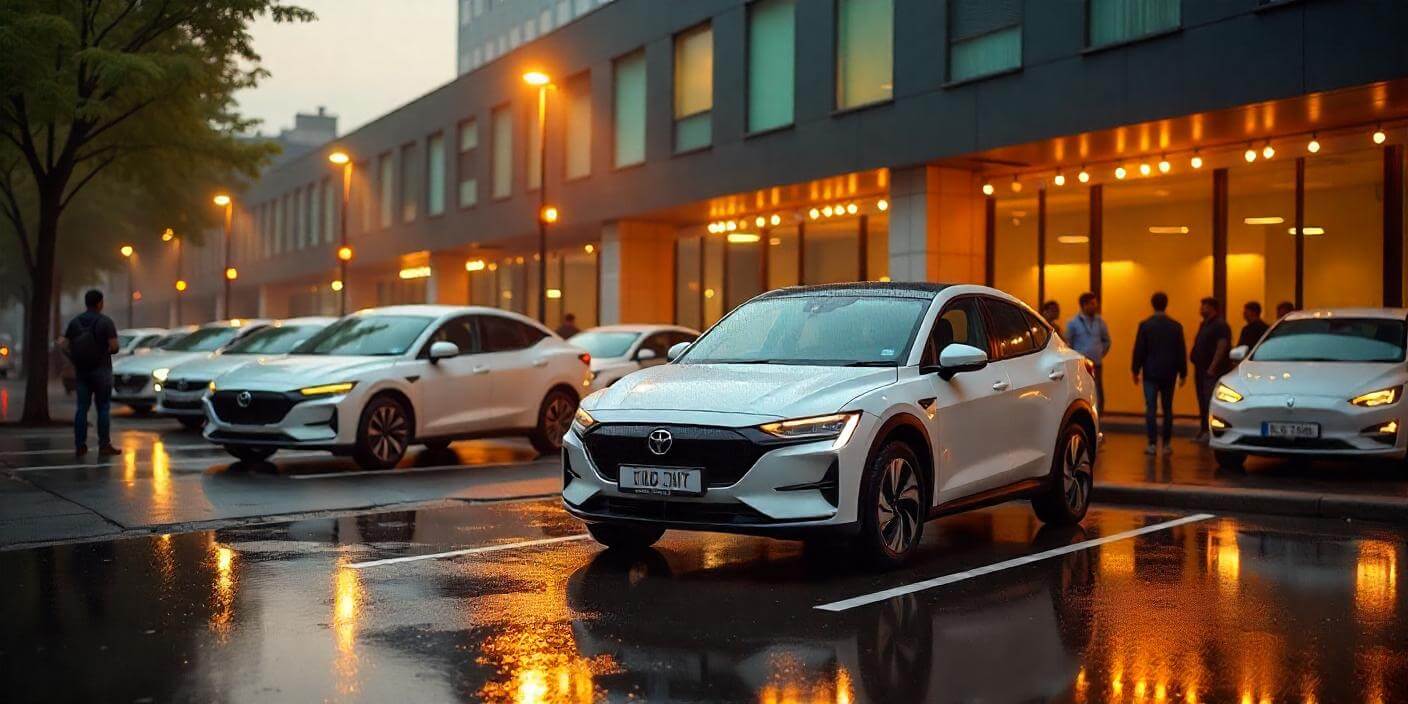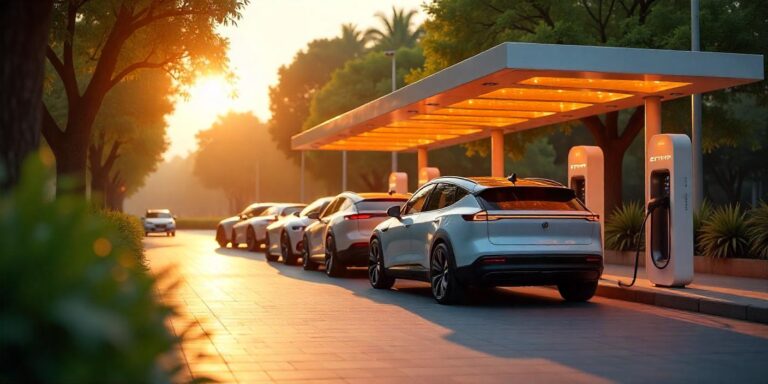Topics Covered
How to Choose the Best Electric Car for Your Business Fleet in India?
Imagine This, Your business fleet runs 100% on electric cars—zero fuel costs, minimal maintenance, and huge savings every year. No more worrying about rising petrol and diesel prices. No more hefty service bills. Just smooth, silent, and efficient operations, all while contributing to a greener future.
But here’s the big question: Which electric car is right for your fleet? With so many EV options, choosing the best one can feel overwhelming.
This guide is your go-to resource for selecting the perfect electric car for your business. We’ll break down cost analysis, range, government incentives, charging infrastructure, and long-term savings to help you make an informed decision. Let’s dive in!
Why Should Businesses Switch to an Electric Fleet?
Lower Operational Costs
EVs offer significant savings on fuel and maintenance compared to petrol or diesel cars.
🔍Insight: “Fleet operators covering 150+ km per day can save over ₹1.5 lakh annually per vehicle by switching to EVs.” — Source: FAME India Scheme
📌 Real-Life Example: A Bangalore-based ride-hailing startup replaced 50% of its fleet with EVs and saw 45% lower running costs, enabling them to increase driver incentives while maintaining profitability.
| Cost Factor | EV (Tata Nexon EV) | Petrol Car (Hyundai Creta) |
|---|---|---|
| Initial Price | ₹15 lakh | ₹12 lakh |
| Running Cost/km | ₹1.5 | ₹9 |
| Maintenance (5 years) | ₹50,000 | ₹1.5 lakh |
| Total 5-Year Cost | ₹17 lakh | ₹22 lakh |
Insight: EVs save businesses ₹5-7 lakh per vehicle over five years when factoring in fuel and maintenance savings.
Government Incentives & Tax Benefits
The FAME-II scheme and state-level incentives make EVs more cost-effective.
Key Government Benefits:
- Subsidies up to ₹1.5 lakh per vehicle for commercial EVs
- Lower GST (5%) vs. 28% on petrol/diesel cars
- State incentives: Road tax waivers, registration fee exemptions
- Tax benefits under Section 80EEB for EV loans
Real-Life Example: A logistics company in Delhi adopted EVs with ₹40 lakh in government subsidies, reducing its fleet acquisition cost by 25%.
🔍 Insight: “Businesses investing in EVs today will gain long-term cost benefits and stay ahead in sustainability compliance.” — Source: Ministry of Heavy Industries
How to Choose the Right Electric Car for Your Business Fleet
1. Assess Fleet Requirements
Different businesses have unique fleet needs.
📌 Real-Life Example: A food delivery company in Mumbai replaced 100 petrol scooters with electric two-wheelers and saw 20% faster deliveries due to lower charging downtime.
What to Consider?
- Daily driving distance: Short-range (<200 km) or long-range (>300 km)?
- Passenger or cargo capacity: Small EVs for last-mile delivery vs. SUVs for corporate fleets
- Charging accessibility: Dedicated depot charging or reliance on public stations?
2. Battery Range & Charging Time
Battery range and fast-charging capabilities are crucial for fleet efficiency.
EV Range & Use Cases:
| EV Type | Range per Charge (km) | Best Use Case |
|---|---|---|
| Small EVs | 150-250 | City deliveries, last-mile logistics |
| Mid-range EVs | 250-400 | Employee transport, intercity logistics |
| Premium EVs | 400+ | Long-distance travel, luxury ride-hailing |
Fast Charging Matters: Look for EVs that recharge 80% in under an hour.
📌 Real-Life Example: A Chennai-based taxi operator adopted EVs with fast-charging stations and reduced idle time by 35%, improving overall revenue.
🔍 Insight: “Fleet EVs with 300+ km range and fast charging can ensure minimal downtime and maximum profitability.” — Source: Tata Power EV Charging
3. Cost Analysis: Upfront vs. Long-Term Savings
While EVs have a higher initial purchase cost, their lower running costs make them a better long-term investment.
💡 Industry Case Study: A corporate shuttle service replaced its petrol sedans with EVs and reported 25% lower total cost of ownership (TCO) over 5 years.
| Expense Type | EV (Tata Nexon EV) | Diesel Car (Hyundai Creta) |
|---|---|---|
| Upfront Cost | ₹15 lakh | ₹12 lakh |
| Fuel Cost/Year | ₹30,000 | ₹1.2 lakh |
| Maintenance | ₹10,000/year | ₹30,000/year |
| 5-Year Cost | ₹16.5 lakh | ₹21 lakh |
🔍 Insight: “Fleets covering 40,000+ km annually will see an ROI within 2-3 years.” — Source: NITI Aayog
4. Charging Infrastructure: How to Set Up Your EV Fleet?
1. In-House Charging Stations
- Install Level 2 AC chargers at your warehouse or office for overnight charging.
- Consider DC fast chargers if your fleet requires quick turnarounds.
2. Public Charging Networks
- Use charging networks like Tata Power EZ Charge, Jio-bp Pulse, and Statiq.
- Apps like ChargeGrid and PlugShare can help locate charging stations.
3. Battery Swapping (For Commercial Fleets)
- Some services offer battery swapping stations, reducing downtime to just 2-3 minutes.
- Ideal for high-usage fleets like e-rickshaws and last-mile delivery services.
📌 Real-Life Example: A Pune-based corporate fleet installed dedicated fast chargers, cutting charging downtime by 50%.
Best Electric Cars for Business Fleets in India (2024-2025)
| Model | Range (km) | Battery | Fast Charging | Best for |
|---|---|---|---|---|
| Tata Nexon EV | 325 | 40.5 kWh | 56 min (80%) | Ride-hailing, corporate fleets |
| Mahindra XUV400 | 375 | 39.5 kWh | 50 min (80%) | Employee transport |
| MG ZS EV | 461 | 50.3 kWh | 60 min (80%) | Intercity fleets |
| BYD e6 | 520 | 71.7 kWh | 90 min (100%) | Premium business use |
| Tata Tigor EV | 315 | 26 kWh | 59 min (80%) | Budget fleet operators |
🔍 Insight: “Tata Nexon EVs for fleet taxis reduce per-km costs by 40% compared to petrol models.”
Leasing vs. Buying: What’s Best for Your Business?
| Factor | Leasing an EV | Buying an EV |
| Upfront Cost | Low (₹10,000/month) | High (₹12-25 lakh) |
| Maintenance | Included in lease | Paid separately |
| Resale Value | No resale concerns | Higher resale potential |
| Flexibility | Can upgrade vehicles easily | Long-term commitment |
✅ Leasing is a great option for businesses unsure about EV adoption. ✅ Buying is better for long-term cost savings if your fleet usage is high.
Final Decision: How to Pick the Best EV for Your Fleet?
Summary Checklist:
- Need a budget-friendly fleet? → Tata Tigor EV
- Require long-range EVs? → MG ZS EV or BYD e6
- Looking for high resale value & incentives? → Tata Nexon EV
🚀 Make the shift today and power your business with the future of mobility!








